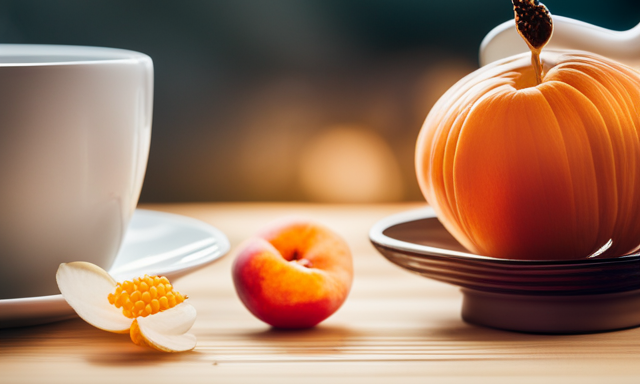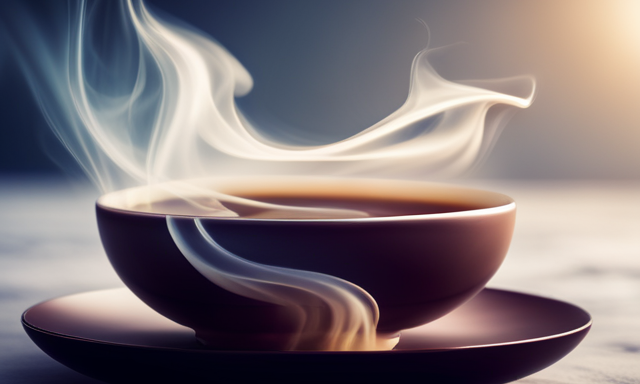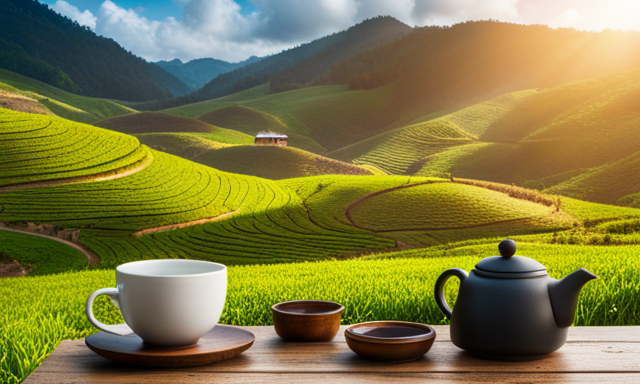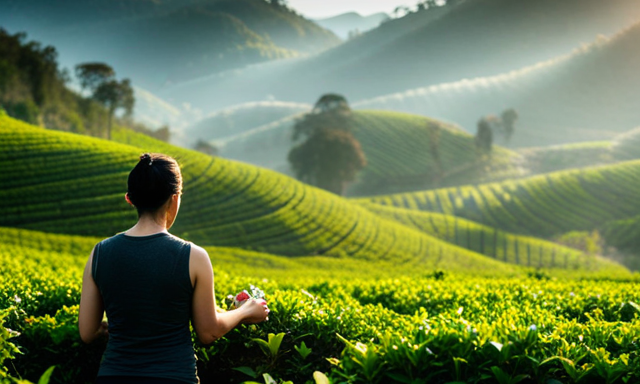I’ve always been a tea lover, constantly on the lookout for new flavors and blends to try. Recently, I found myself torn between two popular options: white tea and oolong. Each has its own unique characteristics and benefits, making the decision even more challenging.
That’s when I realized I needed to dive deeper into the world of tea to truly understand which one is better.
In this article, I will provide a detailed comparison of white tea and oolong tea, exploring their taste profiles, health considerations, and brewing methods. By the end, you’ll have all the information you need to make an informed decision on which tea is right for you.
So, whether you’re a tea connoisseur like me or simply looking to incorporate more variety into your tea routine, join me on this journey as we unravel the mysteries of white tea and oolong tea. Let’s sip our way to a better understanding of these tantalizing brews.
Key Takeaways
- White tea has subtle and sweet flavors, while oolong tea has a wide range of flavor profiles.
- White tea boosts the immune system, promotes healthy skin, and supports cardiovascular health, while oolong tea aids in weight management, improves digestion, and reduces the risk of chronic diseases.
- White tea should be steeped for 3 to 5 minutes, as should oolong tea.
- White tea is known for its light and refreshing taste, while oolong tea is known for its rich and robust taste.
Brief Overview of Tea Types: White Tea and Oolong
When it comes to exploring the world of tea, white tea and oolong are two intriguing options worth delving into.
White tea is known for its delicate and subtle taste profile. It is often described as light and refreshing with floral and fruity notes. It is also renowned for its low caffeine content, making it a popular choice for those seeking a milder tea experience.
On the other hand, oolong tea offers a more robust and complex flavor. It ranges from sweet and fruity to woody and nutty. Its caffeine content falls between that of white and black tea, providing a moderate energy boost.
Moving on to the characteristics of white tea, it exhibits a unique combination of flavors and aromas that set it apart from other tea types.
Characteristics of White Tea
White tea is a fascinating tea type with unique characteristics. Its delicate and subtle flavors make it a popular choice among tea connoisseurs.
The minimal processing and oxidation that white tea undergoes contribute to its light and refreshing taste.
Additionally, white tea is known for its high antioxidant content, making it a healthy beverage choice.
Delicate and Subtle Flavors
Oolong tea offers a unique and delicate taste that is sure to please tea connoisseurs. Its flavor profiles range from floral and fruity to nutty and toasty, making it a versatile option for different preferences.
The brewing techniques for oolong tea are crucial in bringing out its delicate flavors. It’s recommended to use hot water around 180-195°F and steep the leaves for 3-5 minutes to achieve the perfect balance. The subtle flavors of oolong tea can be easily overwhelmed if the water is too hot or the steeping time is too long.
Moving on to the topic of minimal processing and oxidation, this aspect sets oolong tea apart and contributes to its unique taste profile.
Minimal Processing and Oxidation
One fascinating aspect of oolong tea is its minimal processing and oxidation, which gives it a distinct taste profile and makes it stand out from other types of tea.
Oolong tea undergoes unique processing techniques that involve withering, rolling, and partial oxidation, resulting in a tea that falls between the characteristics of green tea and black tea.
The oxidation levels of oolong tea can vary, ranging from 10% to 70%, leading to a wide range of flavors and aromas. The lower oxidation levels produce a lighter, floral and fruity taste, while higher oxidation levels result in a more robust, woody, and earthy flavor. This meticulous process ensures that oolong tea maintains its natural flavors while developing complexity.
Transitioning into the subsequent section about the ‘high antioxidant content,’ oolong tea’s careful processing also contributes to its impressive health benefits.
High Antioxidant Content
Immerse yourself in the world of oolong tea as you discover its captivating allure through its high antioxidant content, bringing a burst of vibrant colors and invigorating aromas to your senses. Oolong tea, a partially oxidized tea, contains a rich array of antioxidants that offer numerous health benefits.
These antioxidants, such as catechins and theaflavins, have been linked to various health effects, including reducing the risk of chronic diseases, boosting the immune system, and promoting heart health. Studies have shown that oolong tea may help lower cholesterol levels, regulate blood sugar levels, and aid in weight management. Its impressive antioxidant content helps to neutralize harmful free radicals in the body, protecting against cell damage and inflammation.
Transitioning into the subsequent section about the benefits of white tea, let’s explore the unique qualities of this delicate beverage.
Benefits of White Tea
To truly appreciate the benefits of white tea, you should definitely try incorporating it into your daily routine. This delicate and minimally processed tea offers a range of health considerations that make it worth considering. Here are four key benefits of white tea:
-
High Antioxidant Content: White tea is packed with antioxidants that help protect the body from free radicals, reducing the risk of chronic diseases and promoting overall health.
-
Skin Health: The antioxidants in white tea can improve skin elasticity, reduce the appearance of wrinkles, and protect against UV damage, keeping your skin youthful and radiant.
-
Weight Management: White tea contains catechins that can boost metabolism and aid in weight loss by increasing fat oxidation and reducing fat storage.
-
Heart Health: Studies have shown that white tea can lower blood pressure and cholesterol levels, reducing the risk of heart disease.
Now, let’s delve into the characteristics of oolong tea.
Characteristics of Oolong Tea
Explore the unique characteristics of oolong tea, with its fascinating flavor profile and a captivating aroma that transports you to a serene tea garden in the misty mountains of Taiwan.
Oolong tea is known for its delicate balance between the freshness of green tea and the richness of black tea. One of its distinguishing features is its range of flavors, from light and floral to deep and toasty. Some oolong teas have distinct floral notes, such as orchid or osmanthus, which add an elegant touch to the overall experience.
The secret lies in the oolong tea processing, which involves withering, rolling, oxidation, and firing. This intricate process brings out the complex flavors and aromas that make oolong tea truly exceptional.
As we delve into the benefits of oolong tea, you’ll discover how this remarkable tea can enhance your well-being.
Benefits of Oolong Tea
As we explored the characteristics of Oolong tea, it’s clear that this tea variety has a lot to offer.
Now, let’s dive into the benefits of Oolong tea. Drinking Oolong tea is believed to provide a range of health benefits. Firstly, it may aid in weight management by boosting metabolism and reducing fat absorption.
Secondly, Oolong tea contains antioxidants that can help protect against free radicals and promote overall well-being.
Lastly, this tea is known to support heart health by reducing bad cholesterol levels. To fully enjoy the benefits of Oolong tea, it’s important to brew it correctly. By using the appropriate water temperature and steeping time, you can maximize the flavor and health properties of this tea.
Now, let’s move on to the next section and compare the taste of white tea to Oolong tea.
Taste Comparison: White Tea vs. Oolong
Discover the delightful flavors and distinct characteristics that set white tea apart from its oolong counterpart. When it comes to taste preferences, white tea offers a delicate and subtle flavor profile that is often described as floral, sweet, and slightly fruity. Its light-bodied nature allows for a smooth and refreshing experience.
On the other hand, oolong tea presents a more complex taste, with a range of flavors that can vary from floral and fruity to toasty and nutty. Its medium-bodied texture provides a rich and robust mouthfeel.
Ultimately, the choice between white tea and oolong boils down to personal taste preferences. Both teas offer unique and enjoyable flavor profiles that cater to different palates.
Transitioning into the subsequent section about health considerations, it’s important to explore how these taste differences may influence one’s choice.
Health Considerations: White Tea vs. Oolong
Indulging in the health benefits of these exquisite teas will leave you feeling invigorated and empowered to make a choice that suits your well-being. When considering the health benefits of white tea and oolong tea, both options offer unique advantages. White tea, known for its delicate flavor and high antioxidant content, is revered for its ability to boost the immune system, promote healthy skin, and support cardiovascular health. On the other hand, oolong tea, with its partially oxidized leaves, provides benefits such as aiding in weight management, improving digestion, and reducing the risk of chronic diseases. To better understand the health benefits of white tea and oolong tea, refer to the table below:
| White Tea Benefits | Oolong Tea Health Benefits |
|---|---|
| Boosts immune system | Aids in weight management |
| Promotes healthy skin | Improves digestion |
| Supports cardiovascular health | Reduces risk of chronic diseases |
Moving on to brewing methods for white tea and oolong, it’s important to explore the different techniques that bring out the best flavors and aromas in each tea.
Brewing Methods for White Tea and Oolong
When it comes to brewing white tea and oolong, it’s important to understand that each tea requires its own set of techniques to bring out its unique flavors.
White tea, known for its delicate nature, should be brewed with water that is just below boiling point, around 175°F to 185°F. It’s best to steep white tea for around 3 to 5 minutes to fully develop its subtle and sweet flavors.
On the other hand, oolong tea, with its more robust and complex flavors, benefits from a slightly higher water temperature, around 190°F to 200°F. Oolong tea should be steeped for 3 to 5 minutes, or longer for a stronger brew.
The brewing techniques for white tea and oolong may differ, but both teas offer a wide range of flavor profiles to explore.
Now, let’s move on to the next section to discuss the conclusion: choosing the right tea for you.
Conclusion: Choosing the Right Tea for You
To make the perfect cup of tea, it’s important to consider your personal preferences and explore the wide variety of flavors available.
When choosing between white tea and oolong, there are several factors to consider. White tea offers a delicate and subtle flavor profile, with floral and fruity notes. It is known for its light and refreshing taste, making it a great choice for those who prefer a milder brew.
On the other hand, oolong tea has a more complex flavor profile, with a range of aromas from floral to earthy. It is known for its rich and robust taste, making it a great choice for those who prefer a stronger brew.
Ultimately, the choice between white tea and oolong comes down to personal preference. Both teas have their own unique characteristics, so it’s worth trying both to see which one suits your taste buds best.
Frequently Asked Questions
How much caffeine is typically found in white tea compared to oolong tea?
White tea typically contains less caffeine compared to oolong tea. However, it’s worth noting that both teas offer unique health benefits. Oolong tea is known for its weight management properties, while green tea is rich in antioxidants.
Can white tea and oolong tea be blended together to create a unique flavor profile?
Yes, white tea and oolong tea can be blended together to create a unique flavor profile. By combining the delicate and floral notes of white tea with the rich and complex flavors of oolong tea, a harmonious and balanced blend is achieved.
Are there any specific health conditions or medications that may interact negatively with white tea or oolong tea?
I’m happy to share some insights on whether specific health conditions or medications can interact negatively with white tea or oolong tea. It’s important to be aware of any potential adverse effects before incorporating these teas into your routine.
What is the recommended steeping time and water temperature for white tea and oolong tea?
For white tea, the recommended steeping time is 2-3 minutes with water temperature around 170-180°F. Oolong tea, on the other hand, is best steeped for 3-5 minutes at a water temperature of 190-200°F. Taste preferences vary based on personal preference.
Can white tea and oolong tea be used for different purposes, such as weight loss or improving skin health?
White tea and oolong tea offer different benefits. White tea aids in weight loss by boosting metabolism, while oolong tea promotes skin health by reducing inflammation. Both can be used for specific purposes, depending on your needs.
Conclusion
In conclusion, when considering the choice between white tea and oolong, it ultimately comes down to personal preference. Both teas offer unique characteristics and benefits.
White tea is known for its delicate flavor and high antioxidant content, while oolong tea boasts a more robust taste and potential weight loss benefits. Some may argue that white tea is too subtle in flavor, but its gentle taste can be appreciated when paired with certain foods.
Regardless of your choice, both white tea and oolong are excellent options for a healthy and enjoyable tea-drinking experience.










